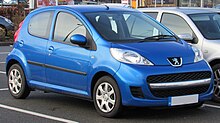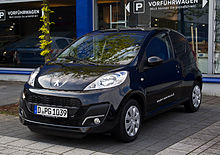| Peugeot 107 | |
|---|---|
 Pre-facelift Peugeot 107 (2007) Pre-facelift Peugeot 107 (2007) | |
| Overview | |
| Manufacturer | TPCA |
| Production | June 2005 – 2014 |
| Assembly | Czech Republic: Kolín (TPCA) |
| Designer | Donato Coco |
| Body and chassis | |
| Class | City car (A) |
| Body style | 3-door hatchback 5-door hatchback |
| Layout | Front-engine, front-wheel-drive |
| Related | Citroën C1 Toyota Aygo |
| Powertrain | |
| Engine | |
| Transmission | 5-speed manual 5-speed automated manual |
| Dimensions | |
| Wheelbase | 2,340 mm (92.1 in) |
| Length | 3,430 mm (135.0 in) |
| Width | 1,630 mm (64.2 in) |
| Height | 1,470 mm (57.9 in) |
| Curb weight | 790–880 kg (1,742–1,940 lb) |
| Chronology | |
| Predecessor | Peugeot 106 Peugeot 1007 |
| Successor | Peugeot 108 |
The Peugeot 107 is a city car produced by French automaker Peugeot, launched in June 2005, and produced until 2014.
The 107 was developed by the B-Zero project of PSA Peugeot Citroën in a joint venture with Toyota; the Citroën C1 and Toyota Aygo are badge engineered variants of each other, the Aygo having more detail differences from the C1 and 107. The three were manufactured at the TPCA assembly joint venture in Kolín, Czech Republic.
The 107 is a four-seater available as a three or five-door hatchback, replacing the 106, which ended production in July 2003. It shares its rear tail light clusters with the Citroën C1, apart from a different red coloured lens.
Engines
| Model | Year | Engine | Displacement | Power | Torque | 0–100 km/h (0–62 mph) |
Top speed | Fuel economy (NEDC) | CO2 emission (g/km) |
|---|---|---|---|---|---|---|---|---|---|
| 1.0i 12V | 2005–2014 | I3 | 998 cc | 69 PS (51 kW; 68 hp) at 6,000 rpm | 93 N⋅m (69 lbf⋅ft) at 3,600 rpm | 12.3 s | 158 km/h (98 mph) | 4.3 L/100 km (66 mpg‑imp; 55 mpg‑US) | 99-109 |
| Model | Year | Engine | Displacement | Power | Torque | 0–100 km/h (0–62 mph) |
Top speed | Fuel economy (NEDC) | CO2 emission (g/km) |
|---|---|---|---|---|---|---|---|---|---|
| 1.4 HDi 8V | 2005–2010 | I4 | 1398 cc | 56 PS (41 kW; 55 hp) at 4,000 rpm | 130 N⋅m (96 lbf⋅ft) at 1,750 rpm | 14.8 s | 154 km/h (96 mph) | 4.0 L/100 km (71 mpg‑imp; 59 mpg‑US) | 109 |
Facelifts



In February 2009, the Peugeot 107 received a facelift aligned with revisions to the Citroën C1 and the Toyota Aygo. Aesthetic changes included revised front bumper, interior, and wheel trims. The front fascia received a wider grille.
The placement of the number plate has been moved from the black stripe in the middle of the grille (which now has a chrome style strip running along with it) to underneath the grille itself and two side vents have been added to give the car an updated look. The interior offered more seat fabric choices and revised centre console graphics. The engine which now produces 106 grams of carbon dioxide per kilometre opposed to 109 before and the Standard Combined Urban Cycle fuel economy has been improved from 61 mpg‑imp (4.6 L/100 km; 51 mpg‑US) to 62.8 mpg‑imp (4.50 L/100 km; 52.3 mpg‑US). A revised clutch was fitted from this model onwards.
In the beginning of 2012, the 107 received a further facelift with a revised bonnet and front bumper/grille with integrated daytime running lights. The interior received a leather steering wheel and a new gearshift on higher-level trims. The official premiere of the facelift was in the Brussels Motor Show.
Reliability
Breakdown statistics reported by the German Automobile Club in May 2010 placed the Peugeot 107 (which the data grouped with the Citroën C1 and Toyota Aygo) at the top of the sub small car class, in respect of the low breakdown rates achieved for cars aged between 1 and 4 years. Class laggards were the Chevrolet Matiz (0–3 year old cars) and the two seater Smart (4–5 year old cars).
In January 2010, PSA announced that it was recalling "under 100,000 units" of the 107 and the Citroën C1, following the worldwide recall by Toyota for a faulty sticking accelerator pedal – which the Aygo is affected by. Under certain circumstances, the pedal can stick in a partially depressed position, or return slowly to the off position.
Safety
| Test | Score | Rating |
|---|---|---|
| Adult occupant: | 26 | |
| Child occupant: | 37 | |
| Pedestrian: | 14 |
| Test | Points | % |
|---|---|---|
| Overall: | ||
| Adult occupant: | 25 | 68% |
| Child occupant: | 36 | 73% |
| Pedestrian: | 19 | 53% |
| Safety assist: | 5 | 71% |
Replacement
The 107 was replaced by the Peugeot 108, which was launched in July 2014.
Sales
| Calendar Year | Europe |
|---|---|
| 2005 | 19,610 |
| 2006 | 91,025 |
| 2007 | 97,225 |
| 2008 | 98,236 |
| 2009 | 117,920 |
| 2010 | 106,408 |
| 2011 | 85,858 |
| 2012 | 69,238 |
| 2013 | 55,244 |
| 2014 | 24,356 |
| 2015 | 88 |
| 2016 | 5 |
| 2017 | 1 |
| 2018 | 2 |
References
- "New Peugeot 108 to be built with Toyota". Auto Express. 2012-11-23.
- "PSA Annual Report 2012" (PDF). Car manufacturers. PSA. Retrieved 12 April 2013.
- http://carfueldata.direct.gov.uk/search-new-or-used-cars.aspx?vid=150807#WeightedResults
- "Peugeot 107 (2005 – 2014) Review". Honest John. Retrieved 2024-12-16.
- "Peugeot 107 facelift (2012) first official pictures". carmagazine.co.uk. 5 January 2012. Retrieved 17 April 2020.
- ^ Wolfgang Rudschies, Hendrik Dieckmann & Thomas Kroher (Michael Ramstetter - Ed) (May 2010). "Die ADAC Pannenstatistik 2009". ADAC Motorwelt: 26–27.
- "Pannenstatistik - Kleinstwagen", ADAC Motorwelt, May 2010, retrieved 2010-05-13
- "Peugeot follows Toyota in Car Recall". BBC News. 2010-01-30. Retrieved 2010-10-17.
- "Euro NCAP results for Citroen C1 1.0 five door LHD hatchback". euroncap.com. 2005.
- "Euro NCAP results for Toyota Aygo 1.0 High Grade, LHD" (PDF). euroncap.com. 2012.
- "New Peugeot 108 to be built with Toyota". Auto Express. Archived from the original on 2 February 2013. Retrieved 17 February 2013.
- "Peugeot 107 European sales figures". carsalesbase.com. 2014-01-30. Retrieved 2020-12-14.
External links
| Peugeot vehicles | ||||||||||
|---|---|---|---|---|---|---|---|---|---|---|
| A brand of Stellantis | ||||||||||
| Current vehicles |
| |||||||||
| Historic vehicles |
| |||||||||
| Motorsport | ||||||||||
| Concept cars | ||||||||||
| Related topics | ||||||||||